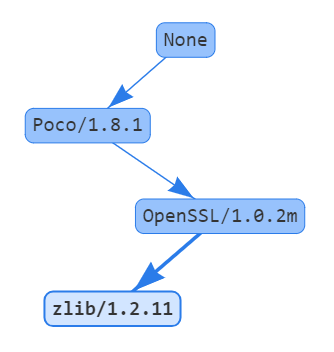Using Conan
How to package header-only libraries?
Packaging header-only libraries is similar to other packages. Be sure to start by reading and understanding the packaging getting started guide. The main difference is that a package recipe is typically much simpler. There are different approaches depending on if you want Conan to run the library unit tests while creating the package or not. Full details are described in this how-to guide.
When to use settings or options?
While creating a package, you may want to add different configurations and variants of the package. There are two main inputs that define packages: settings and options. Read more about them in this section.
How to obtain the dependents of a given package?
The search model for Conan in commands such as conan install and conan info is done from the downstream or “consumer” package as the starting node of the dependency graph and upstream.
$ conan info Poco/1.8.1@pocoproject/stable

The inverse model (from upstream to downstream) is not simple to obtain for Conan packages. This is because the dependency graph is not unique, it
changes for every configuration. The graph can be different for different operating systems or just by changing some package options. So you
cannot query which packages are dependent on MyLib/0.1@user/channel, but which packages are dependent on
MyLib/0.1@user/channel:63da998e3642b50bee33 binary package. Also, the response can contain many different binary packages for the same
recipe, like MyDependent/0.1@user/channel:packageID1... ID2... MyDependent/0.1@user/channel:packageIDN. That is the reason why
conan info and conan install need a profile (default profile or one given with --profile`) or installation files
conanbuildinfo.txt to look for settings and options.
In order to show the inverse graph model, the bottom node is needed to build the graph upstream and an additional node too to get the inverse list. This is usually done to get the build order in case a package is updated. For example, if we want to know the build order of the Poco dependency graph in case OpenSSL is changed we could type:
$ conan info Poco/1.8.1@pocoproject/stable -bo OpenSSL/1.0.2m@conan/stable
[OpenSSL/1.0.2m@conan/stable], [Poco/1.8.1@pocoproject/stable]
If OpenSSL is changed, we would need to rebuild it (of course) and rebuild Poco.
Packages got outdated when uploading an unchanged recipe from a different machine
Usually this is caused due to different line endings in Windows and Linux/macOS. Normally this happens when Windows uploads it with CRLF while Linux/macOS do it with only LF. Conan does not change the line endings to not interfere with user. We suggest always using LF line endings. If this issue is caused by git, it could be solved with git config --system core.autocrlf input.
Is there any recommendation regarding which <user> or <channel> to use in a reference?
A Conan reference is defined by the following template: <library-name>/<library-version>@<user>/<channel>
The <user> term in a Conan reference is basically a namespace to avoid collisions of libraries with the same name and version in the
local cache and in the same remote. This field is usually populated with the author’s name of the package recipe (which could be different
from the author of the library itself) or with the name of the organization creating it. Here are some examples from Conan Center:
OpenSSL/1.1.1@conan/stable
CLI11/1.6.1@cliutils/stable
CTRE/2.1@ctre/stable
Expat/2.2.5@pix4d/stable
FakeIt/2.0.5@gasuketsu/stable
Poco/1.9.0@pocoproject/stable
c-blosc/v1.14.4@francescalted/stable
In the case of the <channel> term, normally OSS package creators use testing when developing a recipe (e.g. it compiles
only in few configurations) and stable when the recipe is ready enough to be used (e.g. it is built and tested in a wide range of
configurations).
From the perspective of a library developer, channels could be used to create different scopes of your library. For example, use rc
channel for release candidates, maybe experimental for those kind of features, or even qa/testing before the library is checked
by QA department or testers.
What does “outdated from recipe” mean exactly?
In some output or commands there are references to “outdated” or “outdated from recipe”. For example, there is a flag --outdated in conan search and conan remove to filter by outdated packages.
When packages are created, Conan stores some metadata of the package such as the settings, the final resolution of the dependencies… and it also saves the recipe hash of the recipe contents they were generated with. This way Conan is able to know the real relation between a recipe and a package.
Basically outdated packages appear when you modify a recipe and export and/or upload it, without re-building binary packages with it. This information is displayed in yellow with:
$ conan search Pkg/0.1@user/channel --table=file.html
# open file.html
# It will show outdated binaries in yellow.
This information is important to know if the packages are up to date with the recipe or even if the packages are still “accessible” from the recipe. That means: if the recipe has completely removed an option (it could be a setting or a requirement) but there are old packages that were generated previously with that option, those packages will be impossible to install as their package ID are calculated from the recipe file (and that option does not exist anymore).